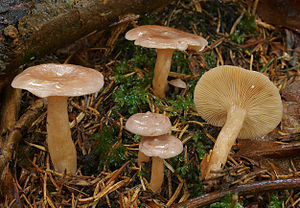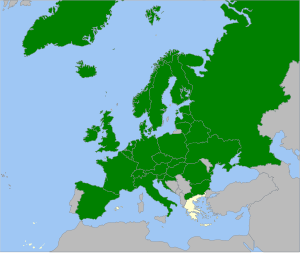Pale coconut flake milkling
| Pale coconut flake milkling | ||||||||||||
|---|---|---|---|---|---|---|---|---|---|---|---|---|

Pale coconut flake milkling ( Lactarius glyciosmus ) |
||||||||||||
| Systematics | ||||||||||||
|
||||||||||||
| Scientific name | ||||||||||||
| Lactarius glyciosmus | ||||||||||||
| ( Fr. ) Fr. |
The Pale coconut milk Ling ( Lactarius glyciosmus ) is a fungal art from the family of Täublingsverwandten (Russulaceae). It is a small to medium-sized milkling that has a pink to cream-brownish, velvety hat and smells typical of the species of coconut flakes. The fruiting bodies of the hot-tasting and inedible milkling appear from August to October on birch trees. Other names for the Milchling are Kleiner Kokosflocken-Milchling or Pale Duft-Milchling .
features
Macroscopic features
The hat is 12–6 cm wide and initially arched and with a rolled edge, but soon spread out and slightly depressed. It often has a small hump in the middle. The surface of the hat is dry, matt to fine-velvety and often covered with ripe or fluffy white. Sometimes the hat skin is also slightly scaly. The hat is light gray, pale gray-brown, gray-pink or flesh-pink and fades from a dull cream-colored to pinkish-brown with age. It is often pale in color at the edge, but mostly not zoned, but can also be indistinctly zoned. The hat is slightly hygrophan when it is damp.
The rather narrow lamellas are attached to the stem or run down briefly. They are quite crowded and more or less mixed in but not forked. They are initially whitish-pink to pale ocher and later pale ocher. With age they are also brownish or gray-brown spotted. The spore powder is cream-colored to pale ocher.
The slender, more or less cylindrical stem is 2–7 cm long and 0.5–1 cm thick. It is quite soft and brittle, and is often compressed or furrowed. The inside of the stem is stuffed first, but it soon becomes hollow. The stem bark is smooth and dry and often slightly frosted at the top. The steep is colored similar to the hat or paler. The base of the stem is often covered with a whitish felt.
The whitish flesh is soft and brittle. When soaked, it is pale cream-colored to pinkish-brown. It tastes mild at first and then slowly becomes slightly spicy and smells slightly fruity and typical of coconut flakes. The relatively sparse flowing milk is invariably whitish and also tastes mild at first and then moderately hot.
Microscopic features
The broadly elliptical spores are on average 6.5–8.1 µm long and 5.0–6.3 µm wide. The Q value (quotient of spore length and width) is 1.1–1.3. The spore ornament is 0.5–1.0 µm high and consists of individual, burr-like elongated warts and ribs, the majority of which are arranged in the manner of zebra stripes and are only partially connected in a network. The hillock is inamyloid or amyloid only in the outer part.
The slightly clubbed basidia measure 28–46 × 8–12 µm and usually have four sterigms . The lamellar edges are heterogeneous and, in addition to the basidia, bear numerous, clubbed to bulbous, 40–85 µm long and 7–10 µm wide cheilomacrocystids . The 40–75 µm long and 7–12 µm wide pleuromacrocystids are club-shaped to spindle-shaped and not very numerous. At the top they are blunt or more or less pointed.
The hat skin ( Pileipellis ) is a poorly developed cutis , which partially merges into a trichoderm . It consists mainly of parallel, 3–12 µm wide hyphae and individual ascending and protruding hyphae ends. The walls of the hyphae are partially weakly gelatinized, with individual lactifera scattered between them.
Species delimitation
The pale coconut flake milkling is almost certainly characterized by its pleasant coconut flake smell and its occurrence under birch trees on dry to fresh soils. Only the slightly larger, darker gray-brown colored dark scented milkling ( L. mammosus ) has approximately the same odor, albeit significantly weaker. It grows in coniferous forests with little lime and is therefore more often found under spruce trees. It also tastes hot and is inedible. The very rare hunched milkling ( L. pilatii ) is also similar . However, it is odorless and the skin of the hat is sticky to slimy and cow-red in color when it is young and fresh and thus reminiscent of cow-red Milchling ( L. hysginus ). Although the Milchling is also a companion to birch trees, it preferably grows in raised bogs amidst dripping wet peat moss cushions. Blown fruit bodies of the purple milkling ( L. lilacinus ) also have a certain similarity . They are a little more robust, smell fruity and grow on alders.
ecology
The Milchling usually grows gregariously or in smaller groups in raised bogs, forests or in parks under birch trees. It is often found in grassy forest areas or in moss cushions on more or less fresh soils with poor bases. The fruiting bodies appear between August and October.
distribution
The Milchling is common in North America (USA, Canada), North Asia (Mongolia) and in Europe. It has also been detected in New Zealand. It is common throughout Fennoscandinavia and its range extends into the Arctic zone. It has also been found on Svalbard and in Greenland. In Central Europe it is rarer and in Southern Europe it appears only in the mountains. The pale coconut flake milkling is widespread in Germany and common in Austria and Switzerland.
Systematics
Lactarius glyciosmus was first described by EM Fries in 1818 as Agaricus glyciosmus , in 1838 he placed it in the genus Lactarius , so that it received its current name. L. glyciosmus is synonymous with Galorrheus glyciosmus (Fr.) P. Kummer 1871 and Lactifluus glyciosmus (Fr.) Kuntze 1891. It was also incorrectly named Lactarius mammosus by some authors ( Quél. , And Rick ) . L. mammosus Fr. , the dark scented milkling is an independent species. The Latinized species attribute ( epithet ) glyciosmus is derived from the ancient Greek words glukos "sweet" and osmos "smell".
Inquiry systematics
The pale coconut flake milkling ( L. glyciosmus ) is the type species of the Colorati section . The representatives of the section have hats ranging from velvety to felted and never greasy. The unchanging milk is scanty and / or watery. At Bon , the Colorati section originally had the rank of a sub-genus. M. Basso puts the Colorati section in the Russularia sub-genus , while Heilmann-Clausen puts it in the Piperites sub-genus .
meaning
Food value
The Täubling is considered inedible in southern and central Europe because of its sharp taste. In Eastern Europe, however, it is still collected as an edible mushroom.
ingredients
Like all Milchlinge, the pale coconut flake Milchling contains various sesquiterpenes , which are also responsible for the sharp taste. Since the sesquiterpenes are first released enzymatically from a fatty acid ester, the meat and milk initially taste mild. The best known sesquiterpenes of coconut milk Ling are the two Lactarane Blennin A and its Sterioisomer Lactarorufin N and the Secolactaran Blennin C. Blennin A and C were - as the name suggests - first from L. Blennius the gray green Milchling isolated and are used in quite a few Milchlingen before. Both compounds have a strong inhibitory effect on the leukotriene C4 biosynthesis and thus have an anti-inflammatory effect.
literature
- M Kuo: Lactarius camphoratus. In: (MushroomExpert.Com). Retrieved June 24, 2011 .
- Roger Phillips: Lactarius glyciosmus. In: rogersmushrooms.com. RogersMushrooms website, accessed June 20, 2011 .
Individual evidence
- ↑ Marcel Bon (ed.): Parey's book of mushrooms . Franckh-Kosmos Verlag, Stuttgart 2005, ISBN 3-440-09970-9 , pp. 88 .
- ↑ Hans E. Laux: The new cosmos PilzAtlas . Franckh-Kosmos, Stuttgart 2002, ISBN 3-440-07229-0 , pp. 192 .
- ↑ a b c Ewald Gerhart: Mushrooms . Ed .: BLV Verlagsgesellschaft. tape 1 : Lamellar fungi, deafblings, milklings and other groups with lamellae. Munich / Vienna / Zurich 1984, ISBN 3-405-12927-3 , pp. 296 .
- ↑ a b Jacob Heilmann-Clausen and others: The genus Lactarius . Fungi of Northern Europe. Ed .: The Danish Mycological Society. Vol. 2, 1998, ISBN 87-983581-4-6 , pp. 168 .
- ↑ a b c d Josef Breitenbach, Fred Kränzlin (Ed.): Pilze der Schweiz. Contribution to knowledge of the fungal flora in Switzerland. Volume 6: Russulaceae. Milklings, deafblings. Mykologia, Luzern 2005, ISBN 3-85604-060-9 , p. 66.
- ^ German Josef Krieglsteiner (Ed.), Andreas Gminder , Wulfard Winterhoff: Die Großpilze Baden-Württemberg . Volume 2: Stand mushrooms: inguinal, club, coral and stubble mushrooms, belly mushrooms, boletus and deaf mushrooms. Ulmer, Stuttgart 2000, ISBN 3-8001-3531-0 , p. 410.
- ↑ Lactarius glyciosmus in the PILZOEK database . In: pilzoek.de . Retrieved September 15, 2011.
- ↑ Worldwide distribution of Lactarius glyciosmus . In: GBIF Portal / data.gbif.org . Archived from the original on April 2, 2015. Info: The archive link was inserted automatically and has not yet been checked. Please check the original and archive link according to the instructions and then remove this notice. Retrieved September 14, 2011.
- ↑ Jacob Heilmann-Clausen among others: The genus Lactarius . Fungi of Northern Europe. Ed .: The Danish Mycological Society. Vol. 2, 1998, ISBN 87-983581-4-6 , pp. 271-73 .
- ↑ Denchev, Cvetomir M. & Boris Assyov: CHECKLIST OF THE MACROMYCETES OF CENTRAL BALKAN MOUNTAIN (BULGARIA) . In: Mycotaxon . tape 111 , 2010, p. 279–282 ( online [PDF; 592 kB ]).
- ↑ Z. Tkalcec & A. Mesic: Preliminary checklist of Agaricales from Croatia V: . Families Crepidotaceae, Russulaceae and Strophariaceae. In: Mycotaxon . tape 88 , 2003, ISSN 0093-4666 , p. 289 ( cybertruffle.org.uk [accessed January 9, 2012]).
- ^ Petkovski S .: National Catalog (Check List) of Species of the Republic of Macedonia . Skopje 2009 ( protectedareas.mk ( Memento from February 15, 2010 in the Internet Archive ) [PDF; 1.6 MB ; accessed on July 9, 2013]). National Catalog (Check List) of Species of the Republic of Macedonia ( Memento of the original from February 15, 2010 in the Internet Archive ) Info: The archive link has been inserted automatically and has not yet been checked. Please check the original and archive link according to the instructions and then remove this notice.
- ^ TV Andrianova et al .: Lactarius of the Ukraine. Fungi of Ukraine. In: www.cybertruffle.org.uk/ukrafung/eng. 2006, accessed February 21, 2012 .
- ↑ Torbjørn Borgen, Steen A. Elborne, Henning Knudsen: Arctic and Alpine Mycology . Ed .: David Boertmann and Henning Knudsen. tape 6 . Museum Tusculanum Press, 2006, ISBN 87-635-1277-7 , A checklist of the Greenland basidiomycetes, p. 37-59 .
- ↑ Mushroom Distribution Atlas - Germany. In: Pilzkartierung 2000 Online / brd.pilzkartierung.de. Retrieved February 21, 2012 .
- ^ Database of mushrooms in Austria. In: austria.mykodata.net. Austrian Mycological Society, accessed on February 21, 2012 .
- ↑ K. Lorenzen & T. Anke: Basisdiomycetes as a Source for New Bioactive Natural Products . In: Bentham Science Publishers (Ed.): Current organic chemistry . Vol. 2, No. 4 , 1998, ISSN 1385-2728 , pp. 348 .
- ↑ For more information, see Templator on meta. Bug reports and feature requests G. Vidari, P. Vita-Finzi: Sesquiterpenes and Other Secondary Metabolites of Genus Lactarius (Basidiomycetes): Chemistry and Biological Activity . In: Atta-ur-Rahman (Ed.): Studies in Natural Products Chemistry . Vol. 17, 1995, pp. 191, 199 .
Web links
- Synonyms of Lactarius glyciosmus. In: speciesfungorum.org. Index Fungorum, accessed June 20, 2011 .
- Lactarius glyciosmus. In: Russulales News / mtsn.tn.it. Retrieved June 20, 2011 (English, photos and original Latin diagnosis).
- Lactarius glyciosmus. In: Funghi in Italia / funghiitaliani.it. Retrieved on February 21, 2012 (Italian, photos from Pale Fragrance Milchling).




